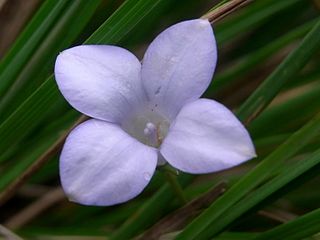
Pittosporum erioloma grows as a shrub or small tree. It is also known as the Lord Howe Island pittosporum or hedge laurel, though it is not a member of the laurel family.
Lepidium nesophilum is a flowering plant in the mustard and cabbage family. The specific epithet is derived from the Greek nesos (“island”) and -philus (“loving”), alluding to its island home.
Lepidium howei-insulae , commonly known as mustard & cress, is a flowering plant in the mustard and cabbage family. The specific epithet alludes to Lord Howe Island, where it is found.

Wahlenbergia insulae-howei is a flowering plant in the bellflower family. The specific epithet alludes to Lord Howe Island, where it is found.

Uncinia debilior is a flowering plant in the sedge family. The specific epithet derives from the Latin debilis, with reference to the species having weaker culms than Uncinia compacta.

Dracophyllum fitzgeraldii, commonly known as the Fitzgeraldii tree or Fitzgerald tree, is a flowering plant in the family Ericaceae. It is endemic to Lord Howe Island, though its closest relatives are species native to northern Queensland and to New Caledonia.
Luzula longiflora is a flowering plant in the rush family. The specific epithet refers to the relatively long floral perianth.

Cryptocarya gregsonii, commonly known as native blackbutt, black plum or laurel, is a flowering plant in the laurel family. The specific epithet honours Jesse Gregson of Newcastle, New South Wales, a botanical friend of Maiden.
Geniostoma huttonii is a flowering plant in the Loganiaceae family. The specific epithet honours Ian Hutton who discovered the species in the course of his explorations of the Island.
Geniostoma petiolosum, commonly known as boar tree, is a flowering plant in the Loganiaceae family. The specific epithet refers to the relatively long and narrow petioles.
Rapanea mccomishii is a flowering plant in the family Primulaceae. The specific epithet honours James Doran McComish (1881–1948), who made several visits to, and collected extensively on, Lord Howe Island in the 1930s.

Rapanea platystigma is a flowering plant in the family Primulaceae. The specific epithet comes from the Greek platys (“broad”) and stigma, with reference to the relatively broad stigma.
Metrosideros sclerocarpa, commonly known as the mountain rose, is a flowering plant in the myrtle family.
Chionanthus quadristamineus, commonly known as the blue plum, is a flowering plant in the olive family. The specific epithet refers to the four stamens in the flowers.

Pandanus forsteri , commonly known as forky-tree or forkedy-tree, is a flowering plant in the screwpine family. The specific epithet honours either Johann Forster or Georg Forster, father and son German botanists, who accompanied James Cook as naturalists on his second voyage (1772–1775).

Piper hooglandii, commonly known as kava, is a flowering plant in the family Piperaceae. The specific epithet honours Dutch botanist Ruurd Dirk Hoogland.

Plantago hedleyi is a flowering plant in the plantain family. The specific epithet honours Australian naturalist and conchologist Charles Hedley, who helped collect the species in 1893.
Coprosma inopinata is a flowering plant in the family Rubiaceae. The specific epithet comes from the Latin inopinus (“unexpected”), because it was discovered unexpectedly in 1989, proving to be yet another species of Coprosma that was endemic to Lord Howe Island.
Coprosma lanceolaris is a flowering plant in the family Rubiaceae. The specific epithet comes from the Latin lancea with the suffix -aris, alluding to the shape of the leaves.

Olearia elliptica subsp. praetermissa is a flowering plant in the daisy family. The subspecific epithet means "overlooked", referring to the fact that this distinctive endemic subspecies was long overlooked.










